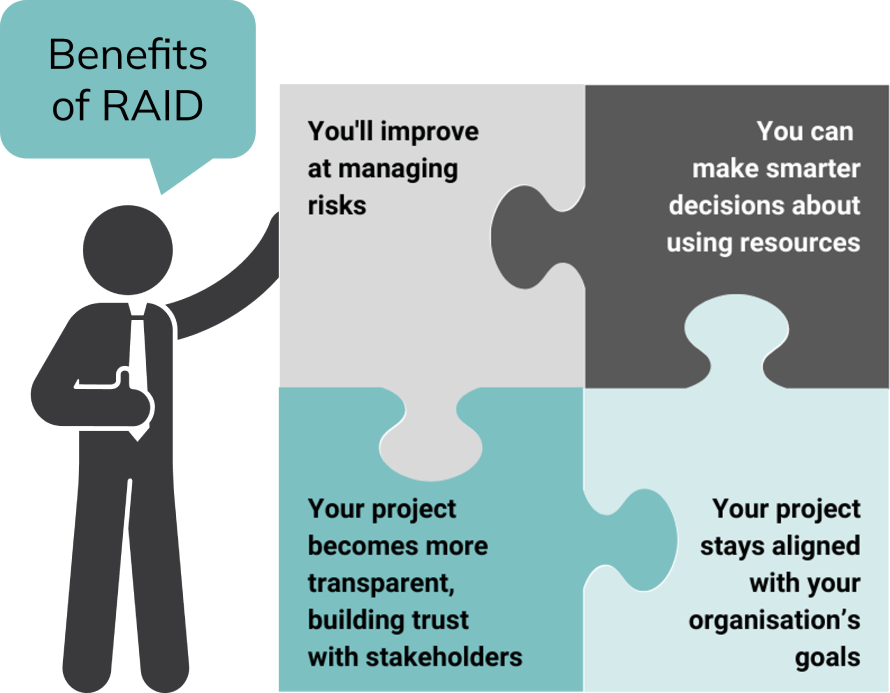
Introduction
In project management, RAID is a crucial framework for success. RAID, an acronym for Risks, Assumptions, Issues, and Dependencies, provides a structured approach to project oversight. This methodology enables project managers to anticipate challenges, clarify foundations, address problems, and map interconnections effectively.
The significance of RAID in project management cannot be overstated. It offers enhanced decision-making capabilities, improved resource allocation and increased project transparency.
By implementing RAID, teams can navigate complex projects with greater confidence and precision.
This article will examine the components of RAID, explore its implementation, and analyse its benefits and challenges. We’ll also look into real-world applications and future trends. Whether you’re a seasoned project manager or new to the field, this comprehensive guide will equip you with valuable insights into applying RAID for project success.
Understanding the RAID framework
The RAID framework comprises four essential components: Risks, Assumptions, Issues, and Dependencies. Each element plays a crucial role in effective project management.
Risks
Project risks are uncertain events that could impact project objectives. Examples include:
- Budget overruns
- Scope creep
- Resource shortages.
Risk assessment involves evaluating the likelihood and potential impact of each risk. Prioritisation techniques, such as risk matrices, help focus efforts on the most critical concerns.
Assumptions
Assumptions are beliefs presumed true for planning purposes. They play a crucial role in project planning by providing a basis for decision-making and highlighting areas of uncertainty.
Validating assumptions throughout the project lifecycle is essential. Document assumptions clearly and review them regularly to ensure their continued relevance.
Issues
Issues are existing problems affecting the project. Identifying and categorising issues involves:
- Regular team meetings
- Progress reports
- Stakeholder feedback.
Timely issue resolution strategies include:
- Clear ownership assignment
- Root cause analysis
- Action plan development.
Dependencies
Dependencies are relationships between project elements. Types include:
- Mandatory dependencies (logical relationships)
- Discretionary dependencies (preferred sequences)
- External dependencies (factors outside project control).
Effective dependency management techniques involve:
- Creating dependency maps
- Utilising project management software
- Regular communication with stakeholders.
By understanding and implementing the RAID framework, project managers can significantly enhance their ability to navigate complex projects successfully.
Implementing RAID analysis in projects
Effective RAID analysis implementation requires a structured approach and appropriate tools. This section outlines the process and best practices for integrating RAID into your project management workflow.
Five steps guide to conducting a RAID analysis
1. Defining project scope and objectives
Begin by clearly outlining your project’s boundaries and goals. This focus will guide your RAID analysis and ensure relevance to your project’s specific context.
2. Organising brainstorming sessions
Gather your team to identify potential risks, assumptions, issues, and dependencies. Encourage open communication and diverse perspectives to capture a comprehensive view of the project landscape.
3. Categorising and documenting findings
Use a RAID log to record and organise the elements identified during brainstorming. Ensure each item is properly classified and described in sufficient detail.
4. Prioritising RAID elements
Assess the impact and likelihood of each item to determine its importance. Consider using a prioritisation matrix to visualise and rank RAID elements effectively.
5. Developing action plans
Create strategies to address high-priority items and assign responsibilities. Ensure each action plan is specific, measurable, achievable, relevant, and time-bound (SMART).
Tools and techniques for RAID analysis
RAID logs and templates
Utilise spreadsheets or specialised templates to track and manage RAID elements. These tools provide a structured format for recording and updating information throughout the project lifecycle.
Software solutions for RAID management
Many project management tools offer integrated RAID functionality. These solutions can streamline the analysis process and facilitate real-time collaboration among team members.
Best practices for ongoing RAID monitoring
Regular review and updates
Schedule periodic RAID reviews to ensure relevance and accuracy. Encourage team members to report new RAID items as they arise, maintaining an up-to-date risk profile.
Stakeholder communication strategies
Share RAID updates in project status reports and address significant items in stakeholder meetings. This practice ensures alignment and fosters transparency throughout the project.
By following these steps and utilising appropriate tools, you can effectively implement RAID analysis in your projects. This approach leads to improved decision-making, enhanced risk management, and increased project success rates.
Benefits of RAID in project management
Implementing RAID analysis offers numerous advantages for project managers and their teams. Let’s explore the key benefits of this comprehensive approach.

Enhanced risk management and mitigation
RAID analysis provides a structured framework for identifying and addressing potential risks. This proactive approach allows teams to:
- Anticipate challenges before they occur
- Develop robust mitigation strategies
- Reduce the likelihood and impact of negative events.
Improved decision-making and resource allocation
By clearly documenting risks, assumptions, issues, and dependencies, RAID analysis supports:
- Data-driven decisions based on comprehensive project insights
- Efficient allocation of resources to high-priority areas
- Timely adjustments to project plans and strategies.
Increased project transparency and stakeholder confidence
RAID analysis fosters open communication and transparency by:
- Providing a clear overview of project status and challenges
- Facilitating regular updates to stakeholders
- Demonstrating a proactive approach to project management.
This transparency builds trust and confidence among stakeholders, enhancing overall project support.
Better alignment with organisational strategies
RAID analysis helps ensure that projects remain aligned with broader organisational goals by:
- Highlighting potential conflicts between project objectives and company strategies
- Identifying opportunities for synergy with other initiatives
- Facilitating strategic decision-making at the project and portfolio levels.
By leveraging these benefits, project managers can significantly improve their chances of delivering successful outcomes and creating value for their organisations.
Challenges and limitations of RAID analysis
While RAID analysis offers numerous benefits, it’s important to acknowledge its potential drawbacks. Understanding these challenges can help project managers implement RAID more effectively.
Potential for overcomplication in smaller projects
For small-scale initiatives, a full RAID analysis might be excessive. It could introduce unnecessary bureaucracy, slow down decision-making processes and consume resources disproportionate to project size.
Time and resource intensity
Conducting thorough RAID analyses requires significant effort:
- Regular meetings and brainstorming sessions
- Detailed documentation and updating
- Ongoing monitoring and review.
This investment may strain teams with limited resources or tight deadlines.
Risk of outdated information
RAID logs require frequent updates to remain relevant. Without consistent maintenance:
- Analyses may become obsolete
- Teams might rely on inaccurate data
- New risks or issues could be overlooked.
Overreliance on RAID analysis
Excessive focus on RAID can lead to:
- Paralysis by analysis
- Neglect of other important project aspects
- Reduced flexibility in responding to unforeseen circumstances.
By recognising these limitations, project managers can adapt their RAID implementation to suit their specific project needs and organisational context.
Real-world applications of RAID
To illustrate the practical value of RAID analysis, let’s examine its application across various industries through case studies.
Case studies across different industries
Construction project example
A large-scale office building construction project utilised RAID analysis to great effect:
- Risks: Identified potential weather delays and supply chain disruptions
- Assumptions: Documented soil conditions based on initial surveys
- Issues: Addressed unexpected archaeological findings during excavation
- Dependencies: Mapped relationships between different construction phases.
The RAID approach helped the team anticipate and mitigate several challenges, ultimately completing the project on schedule.
Software development project example
A fintech startup employed RAID analysis during the development of a new mobile banking app:
- Risks: Highlighted potential security vulnerabilities and regulatory changes
- Assumptions: Clarified user interface preferences based on market research
- Issues: Tackled integration problems with legacy banking systems
- Dependencies: Outlined critical path for feature development and testing.
RAID analysis enabled the team to prioritise security measures and adapt to changing regulations seamlessly.
Event management project example
A global conference organiser implemented RAID for a major international summit:
- Risks: Anticipated potential travel restrictions and venue capacity changes
- Assumptions: Documented expected attendance based on previous years’ data
- Issues: Addressed last-minute speaker cancellations
- Dependencies: Mapped relationships between various event elements (e.g., catering, technology).
RAID analysis facilitated quick adaptation to changing circumstances, ensuring a successful event.
Lessons learned and key takeaways from case studies
These case studies demonstrate that RAID analysis:
- Enhances adaptability across diverse project types
- Facilitates proactive problem-solving and risk mitigation
- Improves communication and alignment among project stakeholders
- Supports successful project outcomes in challenging environments.
By applying RAID principles, project managers can significantly improve their ability to navigate complex projects and deliver successful results.
Integrating RAID with other project management methodologies
RAID analysis can be effectively integrated with various project management approaches, enhancing their risk management and decision-making capabilities.
RAID and Agile Project Management
In Agile environments, RAID can be adapted to support iterative development:
- Incorporate RAID elements into sprint planning sessions
- Use RAID logs as living documents, updated throughout each sprint
- Align RAID analysis with retrospectives to continuously improve risk management.
RAID in traditional waterfall approaches
For waterfall projects, RAID analysis complements existing processes:
- Conduct comprehensive RAID analysis during the planning phase
- Review and update RAID logs at each project milestone
- Use RAID insights to inform stage-gate decisions.
Combining RAID with other risk management techniques
RAID can be integrated with other risk management tools:
- Pair RAID with SWOT analysis for a holistic view of project context
- Use Monte Carlo simulations to quantify risks identified through RAID
- Combine RAID with Failure Mode and Effects Analysis (FMEA) for detailed risk assessment.
By integrating RAID with these methodologies, project managers can create a robust framework for managing uncertainties and dependencies across various project types and industries.
Future trends in RAID and project management
As project management evolves, RAID analysis is poised for significant advancements.
Emerging technologies for RAID analysis
Artificial intelligence and machine learning are set to revolutionise RAID:
- Automated risk identification and assessment
- Predictive analytics for issue prevention
- Real-time dependency mapping and analysis.
Evolving best practices in project risk management
Future risk management practices will likely focus on:
- Integration of big data for more accurate risk forecasting
- Enhanced stakeholder engagement through collaborative platforms
- Adoption of continuous risk monitoring techniques.
Potential developments in RAID frameworks
RAID frameworks may expand to include:
• Environmental and social factors in risk assessment
• Integration with sustainability metrics
• Adaptation for remote and distributed teams.
These trends suggest a future where RAID analysis becomes more dynamic, data-driven, and aligned with broader organisational and societal concerns.
Conclusion
RAID analysis provides a comprehensive framework for managing project uncertainties. By addressing risks, assumptions, issues, and dependencies, it enhances decision-making and project outcomes. Implementation of RAID is crucial for navigating complex projects effectively. We encourage project managers to adopt RAID methodologies to elevate their project management practices and achieve greater success.
FAQs
What does RAID stand for in project management?
RAID represents Risks, Assumptions, Issues, and Dependencies—key elements for comprehensive project oversight.
How often should I update my RAID log?
Update your RAID log regularly, ideally weekly or
bi-weekly, and after significant project events or milestones.
Can RAID analysis be used in small projects?
Yes, but tailor the depth of analysis to suit the project’s scale and complexity.
What’s the difference between a risk and an issue in RAID?
Risks are potential future events, while issues are current problems affecting the project.
How do I prioritise items in a RAID analysis?
Prioritise based on likelihood and potential impact on project objectives, using techniques like risk matrices.
Is RAID analysis suitable for all types of projects?
RAID can benefit most projects, but its application should be adapted to fit specific project needs and methodologies.
How can I involve my team in the RAID analysis process?
Conduct regular brainstorming sessions and encourage ongoing input from team members to identify RAID elements.
What are some common mistakes to avoid when implementing RAID?
Avoid overcomplicating the process, neglecting regular updates, or failing to act on identified RAID elements.
How does RAID analysis improve stakeholder communication?
RAID provides a structured framework for tackling project challenges and strategies with stakeholders, enhancing transparency and trust.
Can RAID analysis help with project budgeting and resource allocation?
Yes, RAID insights can inform budget decisions and help optimise resource allocation by highlighting potential risks and dependencies.
Infographic









